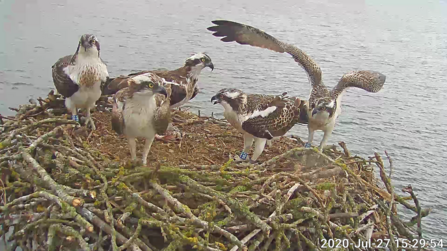It is getting to that time in the season when our ospreys will start to leave Rutland and begin their migration south to their wintering grounds in countries such as Gambia and Senegal. These past couple of weeks we have already seen two of the juveniles from the Manton Bay nest leave – the two youngest 082 and 083. 082 was last seen on the nest and in Manton Bay on Monday 3rd August and 083 on Sunday 9th August.
On average, juvenile ospreys will leave their nesting site a month after fledging, when they are around 82 days old (~12 weeks). 082 and 083, were 85 days and 88 days respectively, when they began their migration. We are expecting 080 and 081 to leave any day now (they are 104 days and 102 days old) and 33(11) is continuing to frequently return to the nest with plenty of fish. Generally speaking, juvenile ospreys won’t fish for themselves until they leave for their migration, but will start to practice techniques and movements associated with fishing over the water and over land.


